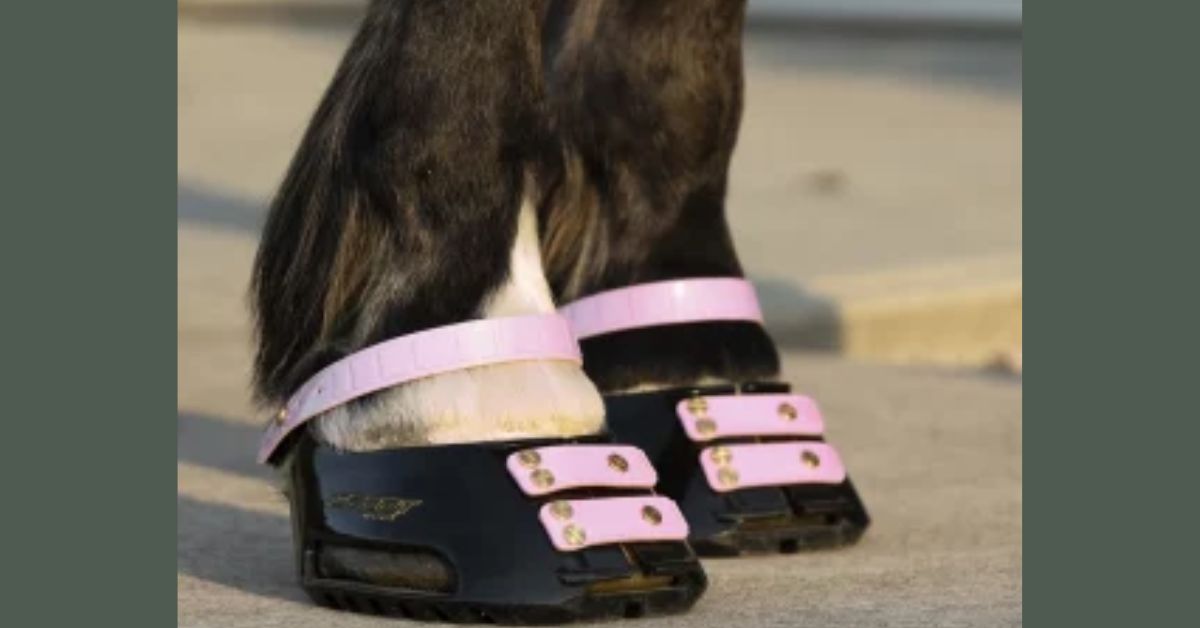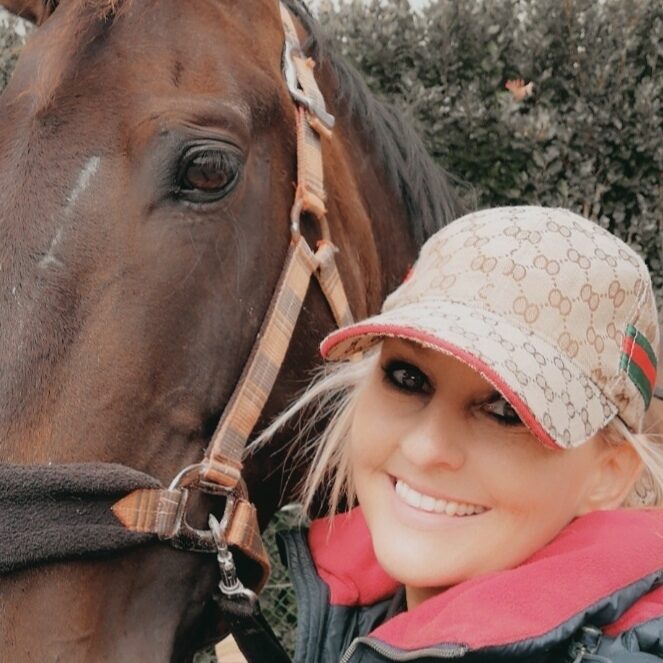Phillippa is the owner of Hoof Boots Ireland, bridle fitter and designer at Bitless Boutique and overall wonder woman also being an Equine Academy Principal, Horsewoman, Author & Columnist!
Today – I want to talk about hoof boots and the reason why there is such a demand for them nowadays – compared to a number of years ago when many of us had never heard of them!

Phillippa – for those of us who have never used a hoof boot- can you please tell us exactly what they are – how they work and the advantages of them?
Sure. So there are a few purposes to hoof boots.
1) Protection for the barefoot horse – reduced wear on the hoof while it adjusts to workload and also acts as a cushion from rocks and other sharp footings that the horse is not accustomed to.
2) Therapy boots – these are used primarily for horses with a hoof condition that needs extra protection, such as in the case of laminitis. They are also helpful for use over a poultice in the case of abscess.
3) Temporary use when a shoe is lost – these are very handy to carry in case your horse throws a shoe while out hacking. Carrying a spare hoof boot is a requirement for higher level TREC competitors. Cavallo TREK are handy for this, they are strong, reinforced boots and there is an additional pad for protection against metal shoes.

Obviously – we are not here to pass judgement on anyone’s individual choice as to whether they shoe or go barefoot – but from your experience – can you tell us the advantages or benefits that you find in barefoot horses?
Absolutely, everyone’s journey is different and we are not anti-shoe, we are pro horse and comfort is key. The main advantage for a healthy hoof being barefoot is the contact with the ground. It plays two key roles:
1) The frog needs contact with the ground as it acts as a pump in the foot, sending the blood back to the heart. The hoof has a vast vascular network not everyone is aware of this. The blood supply is important for a healthy hoof. 3D pads are now more popular with shod horses as this can help with that issue and offers more caudal support. Ask your farrier for more information.
2) Contact with the ground also supports proprioception, the horse is able to make better choices over the ground it finds itself on and this may lead to them being more careful – less likely to pull a muscle or even have better clearance over a jump. We have seen the proof at the Olympics with the barefoot Swedish horses. More and more performance owners are now looking to the benefits of barefoot because of this.
What I would like to add as an important take away, is that there are benefits to barefoot, but that we are also careful to consider that the hoof being bare as it were, is not the whole picture.
As owners we need to be aware of the development at the back of the hoof. If the development is poor, the hoof is less able to support the body correctly and this can lead to compensation. It may not be visible at first because horses are excellent at hiding discomfort. But over time they may change in their stance, gait, muscle mass, and over years even bony changes can be seen where muscle increases or reduces. The back of the hoof starts to develop at a young age; beginning with the pasture the foal moves on – or not if stabled. The movement, access to various footings, diet and trim all play a key role. You see the pedal bone inside the hoof expands and grows until the horse is approx 5 years old. Many horses being shod at 3 or younger in terms of racing, could affect the growth of the hoof, I often find Thoroughbreds to have the smallest hooves – sometimes as small as ponies. I do not think this is natural and cannot correctly support the horse, so the horse remains shod and people say that TBs have bad hooves, that is purely genetic (genes also play a part!).
Hoof boots make it possible to support these horses and those who need to develop a better hoof. I believe it can be done with the right combination of movement, environment, diet and trim. I encourage owners to think about this whole picture and plan for how they will support their horse’s barefoot journey, not just for the shoes coming off, but for months and years to come. Not all horses will be able to manage barefoot completely, but for many of my clients they no longer need the boots and this is the biggest success for me.
I myself have 2 minis and I am looking to introduce a variety of work, including roadwork this year – how do I go about finding what boots would work best for them and also – how does one find the perfect fit for a specific hoof?
There are many hoof boots, some designed over 40 years ago, which may be a surprise to some. Hoof boot design has come a long way in that time, but one thing I have learned, is that boots are each made in a specific part of the world – USA/Australia/Switzerland etc. and they tend to be for the breeds of horses in their area, so they have a ‘type’ of hoof. Now that isn’t to say that one breed can have varying hoof sizes and shapes, but what I am trying to get at is that the measurements alone are not enough, the conformation of the hoof – it’s shaping, angle and heel height – all have a part to play in the “perfect fit”.
I offer my clients two options depending on what they need.
First there is Self-Fitting for the horse owner who is confident to measure and size but needs to rent a selection of fitting shells and get a bit of friendly advice once they are deciding.
The second is the owner who wants lots of support, this is very new and maybe they are nervous. For these clients I have an expert fitting service, where I send a very detailed guide on what I needs, take measurements from photos and assess the history, conformation and requirements. I create a report, recommendations and a custom shell kit to send to the owner to try, proving videos on how to use and assess photos and videos with the kit. I then recommend the boots in order of fit, requirements and budget.
Both can be booked through our website www.hoofboots.ie and we offer your readers a 20% discount with the code EQUITAS
For your own situation, mini hooves are much better catered for these days, as are draft hooves. We fit all from donkeys, minis drafts and all those in between. Cavallo and Scoot both have a mini fit kit, but if we know the measurements and a few photos we may be able to offer even more options.
At this time, we stock Scoot Boot, Cavallo, Easycare, Explora, Swiss Galopper and most recently Equine Fusion. Selecting the right boot is all about what is right for the horse and I’m happy to have a chat with anyone who is looking for more information.
Scoot Boot – A great performance boot, it is lightweight, flexible, flexes to the surface and supports natural movement. They have a great range of colour co-ordinated accessories and are the easiest to fit owing to having lots of customising options from pads to heat stretching.
Cavallo – A classic boot, with lots of designs depending on the size of hoof and also the purpose. Can be used over shoes or as a shoe replacement thanks to their very solid and supportive sole. Very handy to have in an emergency.
Easycare – If you need a therapy boot or an easy on/off general purpose boot they are a super range. They offer super soft pads for horses who need extra protection.
Explora – If you’re a sports rider and want a boot for performance then look no further! These boots are brilliant for speed, durability and have a semi flexible design for rough ground with the ability to fit some serious studs.
Swiss Galopper – popular with draft hooves, they are great for riding over rough terrain and they have a simple, sleek design with build in comfort.
Equine Fusion – Whether you need 24/7 turnout boots, therapy boots, or jogging boots we love the Ultra Terrain, it’s a quality boot, while they aren’t as sleek as other designs, they do the job and do it very well! These are really popular with track systems in the UK as rehab boots, they are really well tried and tested.
Most of the boots we stock can be fitted with studs, these are mostly for protection against ice. Only the Explora offer the option for studs which are matched by shoes.
Are hoof boots in anyway like say a pair of runners for us – are horses prone to the boots rubbing or pinching and so on – or what can we do as owners to ensure their comfort?
I’m glad you brought that up, yes the ‘breaking in’ portion of boot use is important. We just recently created a mini guide for owners which we include for free with every purchase.
We do aim that the boots do not rub, sometimes this requires custom fitting and there are options with some boots for owners to customise the fit at home or they can send them back to us for customisation. Boots only tend to rub if they don’t fit, so I highly recommend taking advantage of our fit kit for peace of mind and also saving time and money in the long run.
Why do the majority of your customers buy hoof boots? Is it for roadwork, to relieve foot issues? Please elaborate!
We have a questionnaire for all owners who take part in the expert fit, and 99% of the time it is for hacking in forestry and roadwork. Both of these over time can be increased barefoot through gentle introduction along with improving the hoof as needed which I covered in the previous question.
If a horse is footy or lame, then I recommend to make sure the horse is okay, because we don’t want to just cover up pain with a boot or a shoe, make sure it’s not more going on and I can’t stress this enough – diet diet diet! It’s one of the biggest causes for footy horses, inflammation from an incorrect diet, poor gut health or early signs of EMS etc.
Do you find as a stockist – that horse owners are more prone to embracing change with products like these? Do you consider these changes are being welcomed as the latest market trend – or the research behind them – or another reason entirely?
Absolutely, while some owners come to me for boots, others end up speaking to me about so much more, because they are seeking answers and wanting to make changes – whether diet, management, training etc. I am delighted to see more professionals recommending us, and I want to give a shout out to the farriers that pass on my number, you know who you are and you’re awesome, thank you!
Speaking of market changes – I know that in the likes of Australia and America – hoof boots have been around and in use a long time. I know myself from reviewing products that on occasion, newer and more “out there “ products can take a while to be accepted in Europe. Why In your opinion, are many countries that much slower to trust in new products?
The biggest change we have seen even in the last few years is choice. The range and design of boots is growing because the need is now there. It’s also down to common practice and education, which relates strongly to acceptance in society.
Europe has been big in to hoof boots for years, many of the designs we work with are in Europe and it’s a huge business in the UK now. When I first wanted to use hoof boots about 6 years ago, I couldn’t find anyone in Ireland, just the one boot dusty on the shelf of my local agri store. Now I stock 6 brands and we are fitting several horses every week and also working with rescues around the country.
As boots are seen as more successful and owners realise the benefits – for hacking and performance (not to mention the financial saving over the cost of shoeing) I think we will see is as a norm, less of a new fad.
What is your main type of customer, if one stands out more? Are they ridden/non ridden? Pleasure horse or competition horse and so on..
My clients do vary, but mainly I meet happy hackers, breeders, rescues and I have even fitted a few GP competition horses.
I would love to help more rescues as those horses have usually been through enough, often with neglected hooves and need comfort asap.
When using hoof boots – is it more common practice to wear on all feet – or just maybe front – or back? Can you explain why?
It depends on why the horse needs boots – if it’s therapy it might be 1,2 or 4 hooves that need support.
For the most part, the happy hacker as it were, they only need fronts. This is because horses put more weight (around 60-65%) on the front hooves if they are comfortable. If the back hooves are in good health and there are no other issues such as SI or back pain, then fronts are what I recommend and see how the horse gets on. Everything is individual and I am happy to offer individual advice for every equine.




